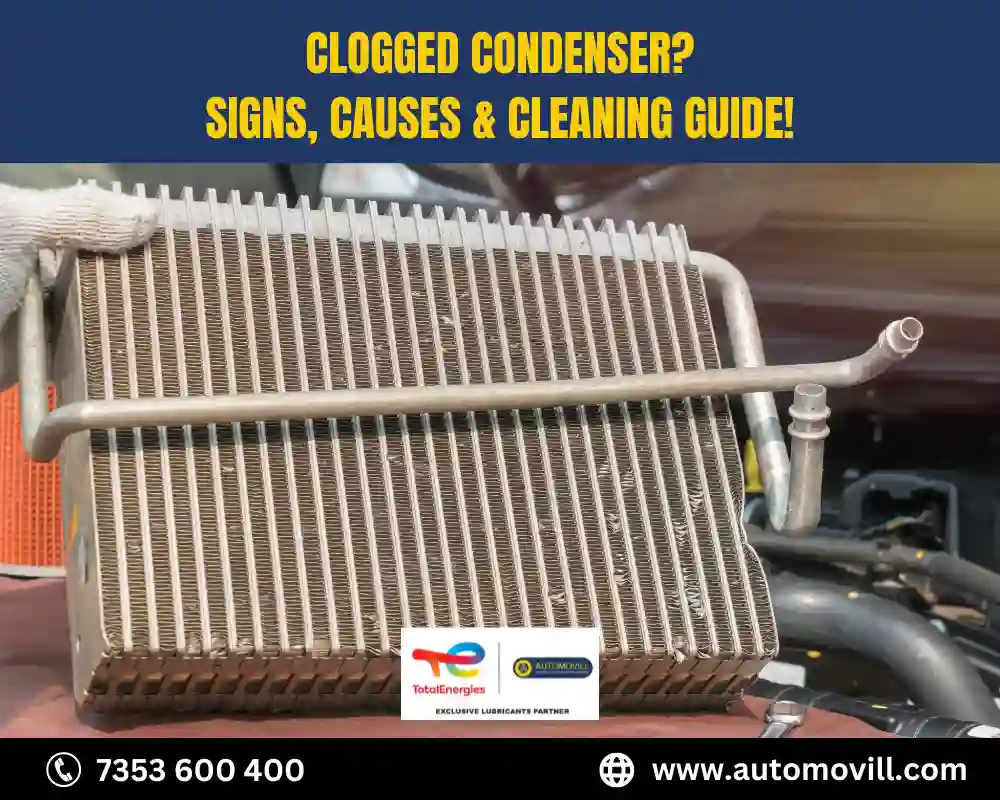
As the scorching heat of summer bears down upon us, your car’s air conditioning becomes a precious protector from the heat waves. But what if that AC is not cooling enough?
One of the common culprits could be a dirty or clogged condenser coil.
Let’s understand the signs of a clogged condenser coil in your car’s AC system, and how it impacts AC’s cooling efficiency.
Signs of a Clogged Condenser Coil
1. Freon Leak (Refrigerant):
The condenser coils can become so clogged that they restrict airflow. This can cause the refrigerant to overheat and break down, which leads to a leak.
2. Reduced Cooling
The most noticeable sign of a clogged condenser coil is a decrease in cooling performance. If you find that your AC isn’t cooling as effectively as it used to, even at maximum settings, it’s time to investigate the condenser coil.
3. Uneven Cooling
Do you feel pockets of warm air while the AC is running? Uneven cooling across different areas of your vehicle’s cabin could be indicative of a clogged condenser coil disrupting the airflow.
4. Increased AC Noise
A clogged condenser coil can force the AC system to work harder, leading to an increase in noise levels. If your AC sounds louder or more strained than usual, it’s worth checking the condenser coil.
5. Higher Fuel Consumption
A clogged condenser coil can impact the overall efficiency of your car’s AC system. This can cause the engine to work harder, leading to increased fuel consumption.
Causes of a Clogged Condenser Coil
1. Dust and Debris
Over time, dust, leaves, and other debris can accumulate on the condenser coil. This buildup obstructs the airflow, reducing the coil’s efficiency.
2. Environmental Factors
Driving in areas with high pollution levels or around construction sites can expose your condenser coil to more pollutants and particulate matter, exacerbating the clogging issue.
3. Lack of Maintenance
Neglecting regular maintenance of your car’s AC system can lead to the accumulation of dirt and debris on the condenser coil.
How to Clean a Clogged Condenser Coil?
Cleaning a clogged condenser coil might seem daunting, but with the right approach, it can be manageable:
Tools You’ll Need:
- Screwdrivers
- Soft brush or compressed air
- Fin comb (optional)
- Mild detergent
- Water source
Steps:
- Safety First: Ensure the car’s engine is turned off and the key is removed from the ignition before starting any work.
- Access the Condenser Coil: Depending on your car’s make and model, you may need to remove some parts to access the condenser coil. Refer to your vehicle’s manual or seek professional guidance if needed.
- Gentle Cleaning: Use a soft brush or compressed air to remove loose dirt and debris from the coil’s fins. Be careful not to bend the fins during this process.
- Deeper Cleaning: For stubborn dirt, you can create a mixture of mild detergent and water. Apply this solution to the condenser coil using a soft brush, then rinse with water. Avoid using high-pressure water as it can damage the fins.
- Fin Straightening: If the coil’s fins are bent, use a fin comb to carefully straighten them out. This improves airflow and overall efficiency.
- Reassembly: Once the coil is clean and dry, reassemble any parts you had to remove initially.
- Test the AC: Start your car’s engine and test the AC to ensure that the airflow and cooling have improved.
Conclusion
A clogged condenser coil can significantly impact your car’s AC performance, making your summer drives less comfortable.
If you address the causes seriously and take necessary action to maintain the efficiency of your car’s AC system, then you will not only get a comfy ride but also prevent further damage.
Regular maintenance will not only keep you cool but also extend the lifespan of your AC components.
